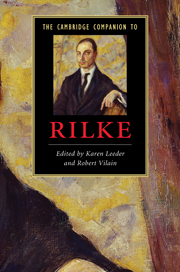Book contents
- Frontmatter
- Introduction
- PART I LIFE
- PART II WORKS
- PART III CULTURAL CONTEXTS, INFLUENCES, RECEPTION
- 8 Rilke and modernism
- 9 Rilke the reader
- 10 Rilke and the visual arts
- 11 Rilke: thought and mysticism
- 12 Rilke and his philosophical critics
- 13 Rilke’s legacy in the English-speaking world
- Appendix: Poem titles
- Guide to further reading
- Index
- Index of works
10 - Rilke and the visual arts
from PART III - CULTURAL CONTEXTS, INFLUENCES, RECEPTION
Published online by Cambridge University Press: 28 July 2010
- Frontmatter
- Introduction
- PART I LIFE
- PART II WORKS
- PART III CULTURAL CONTEXTS, INFLUENCES, RECEPTION
- 8 Rilke and modernism
- 9 Rilke the reader
- 10 Rilke and the visual arts
- 11 Rilke: thought and mysticism
- 12 Rilke and his philosophical critics
- 13 Rilke’s legacy in the English-speaking world
- Appendix: Poem titles
- Guide to further reading
- Index
- Index of works
Summary
While Rilke's poetry is well known to English-speaking audiences through numerous translations, his writings on art are less frequently acknowledged. Rilke himself, who tended to play down literary influences on his work, referred regularly and enthusiastically to the inspiration he had found in visual art. In the decades around 1900 it was not uncommon for German-speaking writers to take an interest in the visual arts. Hugo von Hofmannsthal, Hermann Bahr, Eduard von Keyserling and Rudolf Borchardt were amongst those who took up a tradition already well established in France, and combined writing about art with a literary career. Rilke went further than any other German writer in using ideas from the visual and plastic arts to shape his poetry. The years between his first long stay with the artists of Worpswede in 1900 and his excitement about Cézanne in 1907 mark a continuous development in his understanding of the visual and his ideas about artistic form. The three longer pieces of art criticism (on Worpswede, Rodin and Cézanne) which he produced in this period represent distinct stages in this development, while the two volumes of New Poems published in 1907 and 1908 contain the results of his reflections on the relationship between poetry and visual art, and on the potential of painting and sculpture to provide models for a linguistic art form.
Worpswede was not the first focus of Rilke's interest in art. In the second half of the 1890s he had studied art history, albeit somewhat half-heartedly, in Prague, Munich and Berlin, while rather more enthusiastically following the latest developments in the German art scene.
- Type
- Chapter
- Information
- The Cambridge Companion to Rilke , pp. 145 - 158Publisher: Cambridge University PressPrint publication year: 2010
- 1
- Cited by

